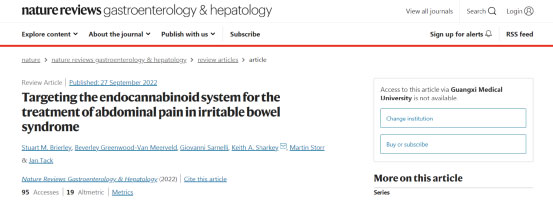
Flinders University: Targeted Endogenous Cannabinoid System for abdominal pain in Irritable Bowel Syndrome.
Disorders of Gut-Brain Interaction (DGBIs) are a group of disorders characterised by chronic or recurrent gastrointestinal symptoms without underlying organic abnormalities.DGBIs are highly prevalent worldwide, have a detrimental impact on patients' quality of life, are one of the main reasons for seeking healthcare and result in considerable healthcare costs.

On 27 September 2022, Stuart M. Brierley and his team from Flinders University, Australia, published a study entitled Targeting the endocannabinoid system for the treatment of abdominal pain in irritable bowel syndrome in the journal Nat Rev Gastroenterol Hepatol (IF: 29.848).
Research Highlights:
1.The management of abdominal pain in bowel-brain interaction disorders, including irritable bowel syndrome [IBS], is challenging.
2.Cannabis and cannabinoids are increasingly used by patients as an alternative therapy for the treatment of IBS pain and altered bowel habits.
3.Cannabis acts on the cannabinoid receptors (CB1 and CB2) of the endocannabinoid system (ECS), which consists of the ligands for these receptors, adenosine and 2-arachidonic acid glycerol, and the enzymes for the biosynthesis and degradation of these ligands.
4.ECS is a logical molecular targeting therapy for the treatment of IBS that regulates gastrointestinal dynamics, secretion, barrier function, inflammation, gut microbiota and visceral sensitivity.
5.Cannabinoid therapies have been developed but have limited use in the treatment of IBS pain. The effects of cannabis have not been rigorously examined in the large clinical trials that are urgently needed.
6.Evidence supports the putative analgesic properties of peripherally restricted CB2 receptor agonists for IBS. Future therapies could target other ECS components for the treatment of IBS and other gut-brain interaction disorders.
Main Results:
DGBIs are defined and classified according to the Rome consensus and are based on a presumed source of symptoms and symptom profile.The best known disorder of DGBIs is irritable bowel syndrome (IBS), which is characterised by chronic abdominal pain associated with altered bowel habits. Pain is a key symptom in several other DGBIs, such as functional chest pain, epigastric pain syndrome, biliary pain, anorectal pain and central abdominal pain. In many of these disorders, visceral hypersensitivity due to disrupted gut-brain interactions is implicated in the pathogenesis of pain, and in DGBIs, peripherally and centrally acting pharmacotherapeutic agents are used to treat senile pain in humans.
Abdominal pain is often considered to be the biggest headache for patients, a key predictor of disease impact and healthcare utilisation, and the most difficult symptom to manage. Due to the challenges of managing abdominal pain, many patients have turned to cannabis as an alternative treatment method due to its perceived beneficial properties. Cannabis and cannabinoid-like substances, such as cannabidiol (CBD), are increasingly available, universally accepted and widely used for recreational and medical purposes, particularly in countries and/or regions where cannabis is legal or decriminalised. Cannabis acts on the receptors of the endocannabinoid system (ECS), an endogenous lipid-mediated signalling system involved in the control of a variety of gastrointestinal functions such as motility, barrier function, inflammation and gut-brain signalling.The ECS is considered a potentially relevant target for the treatment of DGBIs.
This review summarises the current knowledge on ECS and how it can potentially serve as a molecular therapeutic target for the treatment of abdominal pain in IBS and other DGBIs.
The crystal structures, activation and signalling mechanisms of CB1 and CB2 have been investigated in recent years. In particular, the structure of human CB2 reveals how small molecules differ in their effects on CB2 and CB1, the dominant receptor expressed on neurons in the nervous system. In addition, CB1 was found to be intracellularly localised to the mitochondria of neurons and astrocytes, resulting in subcellular-specific CB1 receptor regulation of neural circuits.CB1 was expressed in higher abundance than CB2 in the dorsal root ganglia and enteric nervous system (ENS) of mice and rats.CB2 was predominantly expressed in immune cells and peripheral tissues, including the colonic mucosa, particularly the epithelium, where the CB2A isoforms are predominant. According to animal studies, CB2 is also expressed on central and peripheral neurons, including neurons within the ENS and visceral primary sensory neurons innervating the gut.
Cannabinoid receptors are coupled to Gi/o proteins and, when activated, lead to adenylate cyclase inhibition and reduced cyclic AMP (cAMP) production. In nerves, the release of β-γ dimers leads to inhibition of N-type and P/Q-type Ca2+ channels, activation of inwardly rectifying and A-type potassium channels, and activation of mitogen-activated protein kinase and focal adhesion kinase. In general, activation of cannabinoid receptors is inhibitory, acting as a brake to limit excitation. The binding of cannabinoid receptors to beta inhibitors is a key step in receptor internalization. However, β-inhibitors are also signal transducers of intracellular signalling pathways, such as extracellular signal-regulated kinases and JUN N-terminal kinases, found to mediate some of the effects of endogenous cannabinoids. the CB1 signalling pathway is regulated by the cannabinoid receptor interacting protein 1a, which interacts with G protein-coupled receptors and β-inhibitors to alter function.
ECS is a potential therapeutic target. Given preclinical studies showing beneficial effects of ECS or cannabinoids, and in vivo studies focusing on altered gastrointestinal motility, barrier function, low-grade mucosal inflammation and gut-brain signalling, ECS is a potential target for the treatment of IBS and other DGBIs . This is supported by early observations of cannabinoid effects associated with gastrointestinal motor control and gut peptide signalling in humans.
Conclusion and Outlook:
Pain is part of the symptom spectrum of many DGBIs and is a major determinant of disease severity and healthcare seeking behaviour. In the most intensively studied DGBI IBS, pain is a disease-defining symptom whose presence is associated with visceral hypersensitivity, loss of mucosal integrity and hypo-immune activation. Currently available treatments for irritable bowel syndrome, while having significant symptomatic effects, are less effective in controlling abdominal pain and are often less effective than expected. A large group of drugs designed to control visceral hypersensitivity have been evaluated in clinical trials for the treatment of IBS pain, but none have demonstrated sufficient efficacy to allow full clinical development.

Leave a Comment